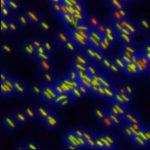Link to Pubmed [PMID] – 24037308
Appl. Microbiol. Biotechnol. 2013 Oct;97(20):8841-8
The re-emergence of tuberculosis in recent years led the World Health Organization (WHO) to launch the Stop TB Strategy program. Beside repurposing the existing drugs and exploring novel molecular combinations, an essential step to face the burden of tuberculosis will be to develop new drugs by identifying vulnerable bacterial targets. Recent studies have focused on decaprenylphosphoryl-D-ribose oxidase (DprE1) of Mycobacterium tuberculosis, an essential enzyme involved in cell wall metabolism, for which new promising molecules have proved efficacy as antitubercular agents. This review summarizes the state of the art concerning DprE1 in terms of structure, enzymatic activity and inhibitors. This enzyme is emerging as one of the most vulnerable target in M. tuberculosis.

